This post has already been read 995 times!
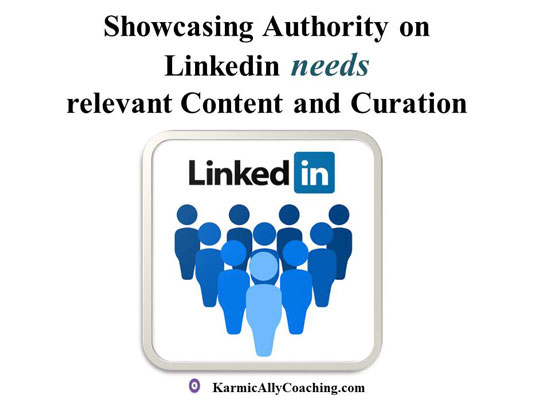
Want to be seen as an authority, a subject matter expert or the go to person for a topic on Linkedin?
Did you answer yes?
Then you simply have to have a robust and strategic content plan for this platform.
The advice to ‘Give Value’ is being repeated almost every day by different influencers and Linkedin experts.
There’s a reason for this.
The content you share on Linkedin builds your reputation. If it’s quality, relevant information and entertaining, your reputation excels. If it’s not relevant, is inconsistent and poorly constructed your reputation takes a hit.
And if you think you can scrape images off Google or copy someone’s blog post and try to pass it off as your own, then you risk damaging your credibility as well.
Especially if the other person finds out, issues you a takedown notice and reports it to Linkedin.
The Emotional Intelligence Post that made me use my own Anger Management Advice
This incident happened to me a few weeks back.
A trainer in Emotional Intelligence used the Hero Image from my blog post on Anger Management and Emotional Intelligence.
WITHOUT my permission to promote her own Leadership and Emotional Intelligence training!
She didn’t know me and had never visited my website or viewed my profile on Linkedin.
She simply scraped the image off Google images ignoring the caveat that the image may be subject to copyright. Had she taken the time to visit my website, she’d have seen my own copyright statements.
It takes time to find the right images for my blog posts and to create them the way I want.
Naturally I was not amused.
I called her out on this and lodged take down notices to her as well as reported it to Linkedin. I got an apology.
Her explanation was not satisfactory. She thought cropping off my website name and logo but giving credit to my business for the image (without a backlink) covered her.
I ended up giving her free advice on copyright and how I could take legal action.
The entire post was removed but the damage to her reputation was done.
There are ways to use other people’s content in an ethical manner which I will share later.
What type of content makes you stand out as an authority or expert?
Your reasons for wanting to raise your visibility on Linkedin may vary.
Maybe you’re a professional looking to raise your visibility for career opportunities or widen your network. You could be a business trying to bring in new clients using content.
Either way keeping consistent with your content in social media can be difficult.
It’s often hard to determine what to post, what type of content you should be using and what will get the most engagement for you.
Moreover, since the Linkedin Algorithm changes from time to time and what worked once might not now.
At one-point images were the rage. But it went too far when the images started resembling Facebook posts. Lots of people started screaming their online lungs out against it with name and shame comments or reposts.
I don’t think they realized they were giving the original content creator some visibility juice! A simpler option would have been simply editing their feed.
They are still popular, but engagement depends on how big a following you have. Posting updates to links to your website or to third party sites got good reach.
Nowadays Linkedin wants to keep people on their site and your reach gets impacted.
But that doesn’t mean you can’t do it. Make sure you add your insights or perspectives with the post.
Polls were popular until everyone was using them. The reach fell depending on how many responses you got in the initial hours of posting & your perceived authority.
They can still be used for engagement and market research provided they are crafted well.
Influencers will always get eyeballs. For us professionals who have to limited time to create content, it’s not feasible to launch into full-time content creation.
One way of staying in line with trends is to be an early user of the new content tools Linkedin provides.
Right now, videos get traction but only when done strategically.
In this post, we’ll briefly look at different styles of content and the best uses for each to showcase your authority and expertise.
Should you be posting videos of your employees or videos of products?
Are presentations allowed on Linkedin?
What is Pulse and how do you use it?
Should I use Polls for engagement?
Then we’ll look at choosing the right content. You’ll also learn what types of content you shouldn’t post on Linkedin.
Finally, I’ll share tips on how to use content curation and other rebranded content to make it easier to stay consistent.
One point I’d like to draw your attention to is to always play to your strengths. Think in terms of showcasing your authority or expertise while creating content and posting.
Styles of Content to demonstrate Your Knowledge
The content you share on Linkedin doesn’t have to solely be written posts. Use content that will be the most engaging to your audience and distribute your brand message across the platform.
Please note, brand here refers to both your professional brand as well as that of your employer or business.
Here are the main types of content recommended on Linkedin and their different uses:
Videos – Videos are one of the easiest ways to grab attention. You can share stand-out content that others will find compelling by sharing your professional tips or demo, lectures, and conversations. Use video to engage viewers by asking a question. Video is also great for sharing everyday work moments to give Linkedin network a backend view.
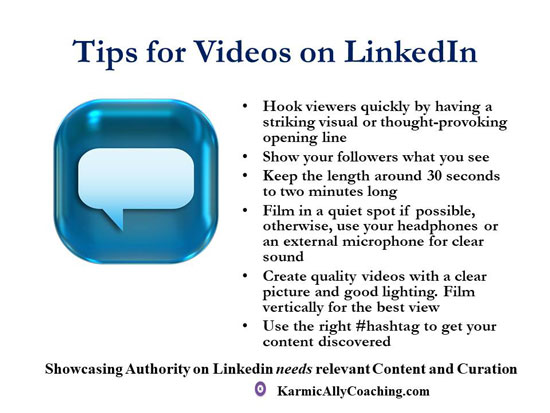
Image Posts – Images are one of the most effective types of content when it comes to time and cost. Images help you stand out by attracting like-minded customers who relate to your brand. Images can be used in both posts and articles. Images can be easily repurposed in other content.
The types of images you can present are unlimited:
- Lifestyle featuring your product or service
- Events
- Company atmosphere and culture
- Cartoons
- Memes
- Gifs
- Behind the scenes images
- Product creation images
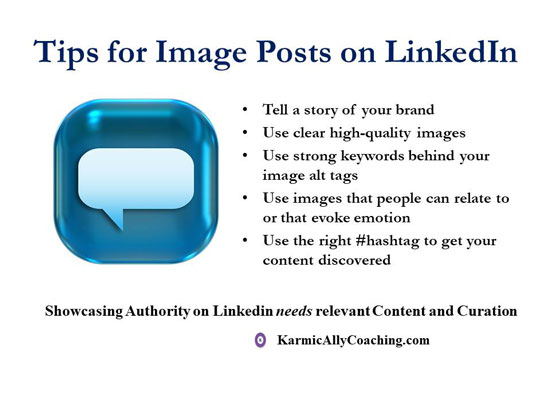
Bonus Tip –Making visuals that get noticed on Linkedin
Text Posts – Posts are short, quick bursts of text to stay connected to your community. Sharing posts on Linkedin will spark engagement, increase your brand reach, and build your relationships. It can contain emojis and hashtags.
People who want to discuss specific topics and concentrate more on their content in words can go with this post. The character limit for text posts is up to 1300 characters. But, in 2022, the character limit was 2973.
I however recommend adding an image for visual effect. There was a trend of pure text posts a few years back in a bid to drive engagement. But it doesn’t really work now unless you’re in a group or pod and everyone is engaging with each other’s posts. Pods as a hack for engagement doesn’t really work anymore.
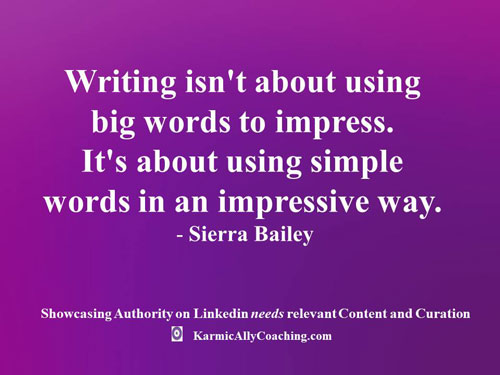
Document Posts– If you want to convey your product to your target audience, but not in article form, you can try this document post. This can be in either PDF, Word, or PowerPoint format. Prepare the document based on what you want to convey to your target audience.
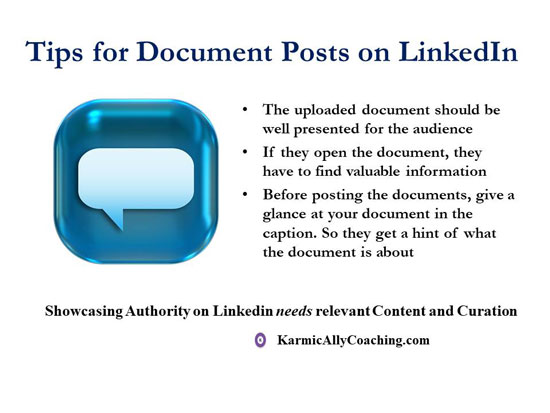
Pulse – Pulse is Linkedin’s publishing platform. This is mainly the place for publishing full length articles to share your knowledge and expertise. It can include links, videos, and images as well. You can write in-depth about your challenges, opportunities, professional expertise, trends happening in your industry and anything relevant to your company. Articles have no word count limit.
Is your Content Engaging?
Providing content that engages your audience is the key to building your network. Engagement is one of the main goals of social media marketing. In fact, according to Linkedin Marketing Solutions, 50% of Linkedin members will buy from companies they have engaged with.
Content plays an important role in attracting your audience. You can do this in many ways.
- Tell a story. Storytelling can and should be a part of every piece of content you produce. You can incorporate how you came to the solution, your process along the way or some story that leads well with the article.
- Use awe-inspiring images or images that tell a story. Don’t just show your product on a plain white background. Instead show images of customers using your product.
- Create compelling headlines and engaging first sentences. The first line should grip your attention: interesting, unusual, emotional, shocking are all human emotional needs that grab out attention.
- Personalize it. People still want to connect or do business with real people. Let your personality and your brand’s personality come through in all your content.
You still need to make friends with Uncle Algorithm on Linkedin
It’s not enough to post content on Linkedin. It’s equally important to get eyeballs on that content.
For that, you need to understand how the Linkedin algorithm works as well when creating engaging content. It’s designed to make your homepage feeds inviting.
The Linkedin feed has a spam filter that determines whether your content will show in the feed, how far an audience it reaches or if you are a spam user.
Here’s my understanding of how the algorithm works:
Stage 1: A computerized bot evaluates your content as spam, low-quality or clear. You want to have clear content to move to the next stage.
Stage 2: The algorithm then measures the initial user engagement such as likes, comments and shares. This signals that your content is good enough to move to the next stage. If you are flagged for some reason as spam by users or hide it from their feeds, Linkedin’s algorithm believes it as negative content. Make sure your content is relevant to other’s professional lives. Is it offensive? Are you over-posting? Is your post unique and insightful?
Stage 3: The algorithm further checks for spam and credibility and quality based on your account and network to determine if the content is spam. The algorithm determines the usefulness and relevance of the post. Engagement is very important at this stage.
Stage 4: In this stage, human editors review the content. They determine whether it should be displayed, boosted, or demoted.
Create engaging content that passes the Linkedin algorithm is necessary for people to see your updates.
Learning how Linkedin’s algorithm works helps you create content that will be seen over and over.
Looking for a great way to build authority and influence in your industry without getting into content creation?
Then it’s time to tap into the power of content curation.
By sharing high-quality content from other experts in your field, you position yourself as a go-to source for information and insights.
Curation also helps develop relationships with people you admire! By sharing their content, you’re saying, “I value your work and I want to help promote it.”
This opens doors to further communication and collaboration down the road.
Content Curation and Automation
Now that you know why you need to create engaging content and the algorithm for Linkedin, it’s time to learn about ways to automate your content creation.
Content curation and automation tools make being consistent easier. There are many types of content that can be used for all your content needs.
Content curation is gathering a collection of content and adding value and your voice to it. The content comes from a variety of sources, around a specific topic which you share with your followers. You sift through articles on the internet, collect those that are the most interesting and relevant to your industry and share them in blog posts and on Linkedin.
Content curation allows you to create posts quickly using other peoples content the right way. You’re sharing resources and rare content that isn’t the same article found on a million other feeds.
3 Benefits of Content Curation:
- Saves you time and energy
- Elevates your brand visibility
- Establishes your authority and thought leadership
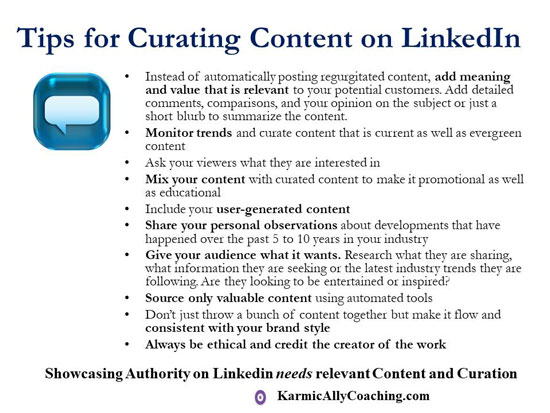
Next you want to automate as much as you can to keep content consistently in your Linkedin feed. Use a social media calendar to determine what you’re going to post.
Then use tools and programs to schedule your posts. This way the work is done once and then can be posted hands off.
Automation tools are great for scheduling any batch writing you do as well. By creating and scheduling posts in bulk, you free up time that can be used in better ways.
Use one of these suggested programs
- Hootsuite offers a bulk composer feature to make it easy to schedule post across different social networks at once, including Linkedin.
- Pocket is an app that let’s you gather content in one place from your browser or from apps like Pulse.
- Feedly is the most popular RSS and blog reader online. It allows you to subscribe to your favorite websites, blogs, publications, and YouTube channels, getting the content to read, save or share it.
- DrumUp is an app that goes through tons of web content to bring you the freshest and most relevant stories.
- Buzzsumo is packed with helpful features. You can search for the most shared content using keywords, domains, or specific types of content like guest post or videos.
- Quuu offers a free plan. This content curation program is the only tool where each and every piece is hand-reviewed by humans. Quuu sends the content directly to your Hubspot or Buffer schedule.
- Curationsoft is a desktop-based curation software that allows you to find, evaluate and curate content into a drag and drop HTML editor. It can be used to create a blog post that you share on Linkedin or used as an article on Linkedin.
Content curation is a time and money saver and should be a part of your social media strategy. Using one of the many tools available to curate the content for you makes it even easier to share quickly.
A word of caution about using automation on Linkedin
Use the automation tools only for content curation. Please don’t use it for connecting with people or sending them bot messages. This is not allowed on Linkedin and you risk getting your account closed.
For more information on what tools can make you lose your Linkedin account, please read this article by Mic Adam. It’s worth bookmarking.
Types of Content
Now that you know why you need to curate content and how to do it easily, you might be wondering what types of content to post. The type of content can be anything, well, almost anything.
It can be things like …
- Everyday stuff (related to the business and not related). This can be as simple as what or where you had dinner with your amazing team or the fishing trip you made with your family. Take on a spicy (and tactful) point of view on a trending non-business topic.
- Industry information. Linkedin is a business-to-business platform so it’s only logical to share content related to your industry. You can share reports, whitepapers, long-form content, videos.
- Post Results. Did your company participate in a competition recently? Post the results of how you did. Post results of how a new marketing campaign or product launch fared.
- Case Studies. Show your audience how others have used your product and services through a case study.
- Share articles you like. Don’t just talk about you and your company. Share articles from your competitors and others in your industry that are trending and interesting.
- Post industry statistics. People love statistics so share industry and company stats as part of your marketing campaign.
- Share client testimonials. Gather testimonials and endorsements from your satisfied clients to boost your authority and leadership.
- Share how to videos and articles. Share videos along with articles on how to use your products or services for the best results. Use list-style posts as well. Marketing guru Neil Patel has built a following using this style of posts on Linkedin.
- Product launches and feature updates. Keep your audience aware of the latest products or services you have.
- Offer quick tips. These simple and short posts include leadership tips and tricks that encourage productivity, leadership, and professional success. Or offer simple text quotes relevant to your followers.
- Share company updates. Find interesting and visual ways to share company updates on what’s happening in your company. It’s a great way for your audience to get to know you and your company better.
- Share photos of your company, your employees, and the activities they do daily. Share photos taken at business events you attend.
- Humanize your company. Highlight your best employees as thought leaders.
- Use Showcase pages to drive registration to events your company is hosting or sponsoring.
- Share lessons learned. It doesn’t matter what your age or industry is, you have learned important lessons that others can benefit from. Share them with others.
- Make predictions. It doesn’t matter whether you are right or wrong, predictions are a way to get a discussion going.
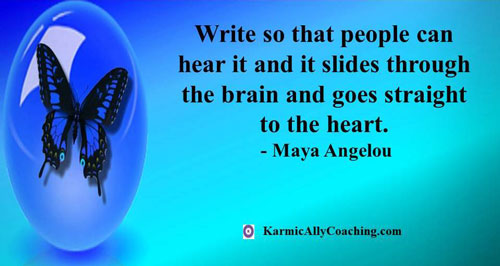
Final Words on building authority and expert status on Linkedin using Content
Content is the key to building your following on Linkedin. You want to dominate with your content through consistency, quality, and variety.
To do this you need to use tools for automating the process, use other people’s content correctly and post a variety of types of content.
The styles of content you use depends on your topic as much as how you want to present it. A video might be the right fit for certain topics while a SlideShare presentation would fit better for others. Sometimes a quick funny image is all you need to share.
Whichever style of content you choose; the key is making it quality and relevant. One way to do that is to curate content about your industry.
Curated content can save you time and money. And with automation tools you can put together a curated piece in a fraction of the time of doing it yourself.
The type of content you present is as wide as you want it. Post updates on your company or products, show research you’ve done, or share videos about your employees or brand.
Keep your followers up to date on what’s happening in your business, the industry, and upcoming trends. Finally, humanize your brand by posting about non-business events occasionally.
What content will you post on Linkedin today?
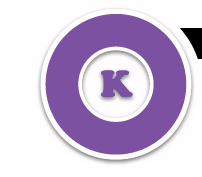
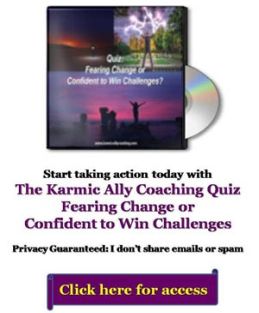
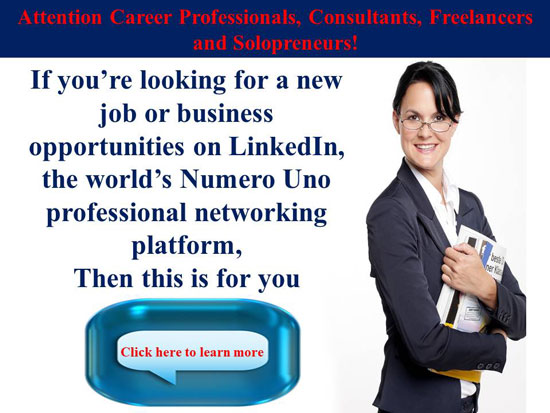

 I adhere to the Certified Coaches Alliance Code of Ethics and Standards. A copy is available on request.
I adhere to the Certified Coaches Alliance Code of Ethics and Standards. A copy is available on request.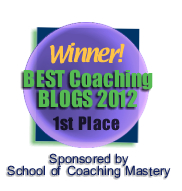
 Let's Talk through the Connect Form:
Let's Talk through the Connect Form: